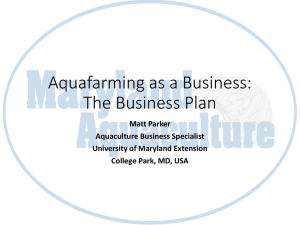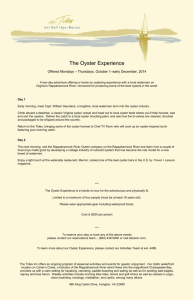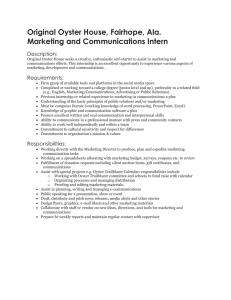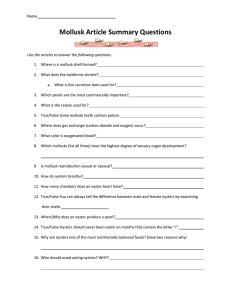Oysters have been an integral part of the life of... came to settle its surrounding territory. They provided sustenance... Maryland Oyster Culture: A Brief History
advertisement
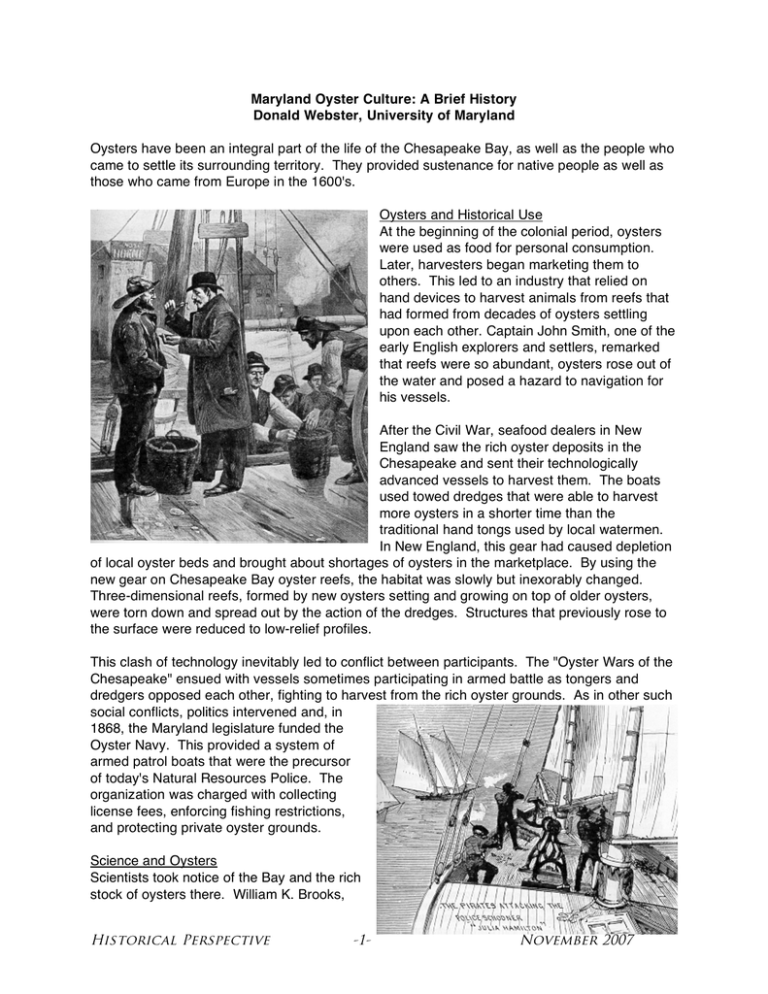
Maryland Oyster Culture: A Brief History Donald Webster, University of Maryland Oysters have been an integral part of the life of the Chesapeake Bay, as well as the people who came to settle its surrounding territory. They provided sustenance for native people as well as those who came from Europe in the 1600's. Oysters and Historical Use At the beginning of the colonial period, oysters were used as food for personal consumption. Later, harvesters began marketing them to others. This led to an industry that relied on hand devices to harvest animals from reefs that had formed from decades of oysters settling upon each other. Captain John Smith, one of the early English explorers and settlers, remarked that reefs were so abundant, oysters rose out of the water and posed a hazard to navigation for his vessels. After the Civil War, seafood dealers in New England saw the rich oyster deposits in the Chesapeake and sent their technologically advanced vessels to harvest them. The boats used towed dredges that were able to harvest more oysters in a shorter time than the traditional hand tongs used by local watermen. In New England, this gear had caused depletion of local oyster beds and brought about shortages of oysters in the marketplace. By using the new gear on Chesapeake Bay oyster reefs, the habitat was slowly but inexorably changed. Three-dimensional reefs, formed by new oysters setting and growing on top of older oysters, were torn down and spread out by the action of the dredges. Structures that previously rose to the surface were reduced to low-relief profiles. This clash of technology inevitably led to conflict between participants. The "Oyster Wars of the Chesapeake" ensued with vessels sometimes participating in armed battle as tongers and dredgers opposed each other, fighting to harvest from the rich oyster grounds. As in other such social conflicts, politics intervened and, in 1868, the Maryland legislature funded the Oyster Navy. This provided a system of armed patrol boats that were the precursor of today's Natural Resources Police. The organization was charged with collecting license fees, enforcing fishing restrictions, and protecting private oyster grounds. Science and Oysters Scientists took notice of the Bay and the rich stock of oysters there. William K. Brooks, Historical Perspective -1- November 2007 Ph.D., a biologist at the Johns Hopkins University, was an early researcher who took great interest in the oyster. He not only studied the animals, but was familiar with the people who harvested, processed, and marketed them as well. In 1891, Brooks wrote a popular treatise on the industry entitled "The Oyster.” It included a history of the regional industry and references to historical attempts to culture the animal back to the Roman Empire. The book included survey information on oysters throughout the Bay. The data were collected by Brooks and Lt. Winslow of the U.S. Navy, another early oceanographer whose interest in oysters helped drive conservation. Brooks' book included sepia-tone plates of pictures of oysters taken during his survey trips that showed their abundance at that time. While Brooks’ (1891) information was well received, his recommendations to the State for conservation, as well as his calls for the expansion of production through aquaculture, brought immediate conflict. Brooks reasoned that culture techniques were within the ability of most harvesters and urged watermen to form cooperatives and farm the Bay. He chronicled techniques that had been developed elsewhere and argued that their application in the Chesapeake Bay could help expand production, bettering both the industry and the lives of the local people who harvested them, while providing quality food products. His main thesis was that watermen should themselves be in charge of managing the oyster resources – both the public resource, as well as creating private culture – for the betterment of their future. It is interesting to note that Brooks was calling for increased production at a time when the harvest was already above ten million bushels a year. Some agreed with Brooks’ ideas, but many others did not. Immediate and intense response resulted from his suggestion to increase leasing of the Bay bottom for private cultivation. Watermen and their politician supporters fought plans that were put forth to help them in this manner. They believed that if people had rights to bay bottom, harvesters would be relegated to working less productive grounds. However, this was not the case, as Brooks proposed that productive grounds be delineated and reserved for the public harvest with only areas deemed "barren" to be leased for cultivation. Therefore, it was the intent to lease barren bottom and create a private aquaculture segment to the industry that drove the need to survey natural bars in the first place. A survey of Maryland oyster grounds was funded by the legislature. This was overseen by Yates during the period from 1906 to 1912 and formed the basis of Maryland’s Natural Oyster Bars (NOBs), which exist today. These grounds were to be considered "off limits" to leasing or private control and reserved for harvest by citizens of Maryland. It should be noted that the survey to delineate grounds to be reserved for the public fishery was done because of the interest that existed in using the remaining grounds for the purpose of farming oysters, or aquaculture. It can be seen that it would not have been necessary to survey natural oyster reefs Historical Perspective -2- November 2007 if there was no intention to lease the non-productive areas. In other words, if the state had only intended oysters to be harvested as a public resource it would not have been necessary to survey these areas and reserve them for public harvest. With the survey, the legislature passed another oyster culture law, named the “Haman Oyster Law” after the Baltimore legislator who championed aquaculture during his stay in office. This bill followed the initial “One Acre Law” passed in 1820 (making Maryland the third state in the nation to pass an oyster aquaculture law) and the “Five Acre Law” of 1865, which amended it. The Haman act provided citizens the right to increase leases from the former limit of five acres to new maximums, based on geographic location. Some watermen availed themselves of the opportunity to do this. Processors, who shucked the meat from the oysters, often provided leftover shell to the growers, or sold it to them at minimal cost. Growers then placed it on barren bottom to form a calcium substrate. During the summer, free-swimming larvae, the result of oysters spawning naturally, began searching for shell on which to settle and grow. Many would find the shells and cement themselves to them. They would go through metamorphosis, changing from their freeswimming state to become 'spat' or juvenile oysters, where they would begin producing shell and growing to legal size. Historical Perspective -3- November 2007 The Politics of Oysters From the beginning, however, growers had problems. Watermen who did not want bottom leased opposed the growers. Theft of oysters became a significant problem. Since oysters were unable to be branded, it was difficult to differentiate between oysters from public bars or reefs and those from private grounds. Stories were told of leases being looted during periods of fog or at night, which helped shield the thieves from view. While Maryland had a significant marine police force that had evolved from the “Oyster Navy” originally intended to enforce boundaries between dredgers and tongers, the force was spread around the several thousands of miles of coastline and was often unable to police leases. Even when thieves were caught, local prosecutors and judges would not consider the taking of oysters to be a significant offense. Fines were so small that the thieves would consider them a cost of doing business, figuring that they would be able to escape from notice so many times that the small fine that might result from being found on leased grounds was a small price to pay for the overall economic return. Conflict between growers and watermen continued for decades. The peak of Maryland harvest was at the end of the nineteenth century, when landings reached twelve million bushels of oysters. Thereafter, this declined, as the resource continued to be exploited, often without regard for the future. Every time the State investigated ways to increase oyster harvest, those who would point to private cultivation as an alternative were criticized as wanting to privatize public resources. The politics of leasing continued over many years as watermen successfully blocked efforts to expand leased bottom in many locations. In addition to legislative roadblocks aimed at growers, individual watermen blocked leases through the system set up to adjudicate problems. This occurred during the application process for leases, which required a notice of the application be placed in local newspapers. Waterman wishing to protest the lease had only to show up in front of the judge and affirm that they had caught a “day’s work” from the area during the past five years. When this occurred, the lease would be denied and the ground would be considered NOB. During the 1960s, watermen were successful in further legislatively restricting leasing in many of the most productive counties of Maryland. New leases were prohibited in all counties of the Eastern Shore except Worcester, which had only coastal bays, and Wicomico, which had developed significant production through leased grounds. Also, enacting prohibitions against further leasing were the western shore counties of Anne Arundel, Calvert, St. Mary’s, and Charles. While counties in the Upper Bay were not included, oysters were not normally found there and were therefore not suitable for cultivation. Aquaculture Development Wicomico County was an anomaly in the State of Maryland. Approximately twenty-six percent of the leased grounds in the state were located there. This situation had developed over many decades, due in large measure to the H.B. Kennerly Company, whose packing and processing facilities were located on the harbor in Nanticoke. When the leasing laws were passed at the turn of the century, the owner of that company had urged local watermen to obtain leases, which many did. The company provided shell from their shucking operation to growers in order to stabilize the bottom and provide a substrate to attract young oysters. When the oysters were ready for market, the company purchased them from the Historical Perspective -4- November 2007 growers, deducting a small fee for the shell. This symbiosis allowed the growers, most of whom were watermen who worked public oyster bars during tonging season, to increase their income while providing them a livelihood between the end of the public oyster season and the time when they began crabbing. It allowed the Kennerly Company to become a major supplier of oysters, servicing markets far from Maryland with high quality shellfish, on a year-round basis. Watermen in other areas also tried aquaculture. In 1952, a group of Smith Island watermen got together and leased two tracts of submerged bottom near their island. These parcels amounted to 500 hundred acres, which watermen planned to farm in concert with each other. One lease was 200 acres in size and the other included 300 acres. Their objective was to provide substrate for natural recruitment in an area known for annual spat falls. When the oysters grew to market size, they would harvest them as the market allowed, creating income for those working together on the project. Had this experiment worked, it would perhaps have served as a model for other watermen. It would have shown that they could work together as Brooks' had suggested in his 1892 book, forming cooperatives and farming the Bay. Unfortunately, a 1954 hurricane severely harmed the grounds and led to an abandonment of the project before harvest. There were also large tracts leased in the Patuxent River, South River, and the West and Rhode rivers on the western side of the Bay, as well as smaller parcels in the Severn and Magothy. These were located close to packing and processing houses, providing convenience for growers to sell oysters at harvest. In time, smaller growers abandoned their operations, often selling their leases to others, until the overall number of leaseholders declined. While there were over six hundred leases still recorded in the late 1970s, the actual number of people who held them was fewer than four hundred. Early in the 1970s, there was a resurgence of interest in oyster growing largely due to the production shift from the lower to upper Bay. In keeping with the tradition of preventing individuals from leasing bottom, watermen were able to get the Maryland legislature to enact a moratorium on new leases until the bottom could be resurveyed. They stated that this had not been done since the 1906-1912 survey and that revision was necessary for assessments of bottom to be made. While this seemed logical to construct a workable aquaculture program, the effect was to ban further leasing. The Maryland Department of Natural Resources (MDNR), as the agency responsible for carrying out the resurvey, received no funding to do it and just ignored it for many years. Private cultivation of oysters was, therefore, restricted to the grounds that had already been leased. New entrants could only transfer grounds that had already been leased. A single change occurred in May 1978. This provided an exemption for the waters of Worcester County from the moratorium, since it was understood that there were no naturally occurring populations of oysters there anymore due to disease. Resurvey of the Bay’s oyster bars languished into the 1980s when it was finally completed by the MDNR. Instead of showing a decrease in the amount of natural bar acreage in the Bay, the new survey straightened out existing lines and resulted in more designated natural oyster bar than at the beginning of the century. Much of this area was no longer productive oyster bottom, Historical Perspective -5- November 2007 but was classified as Natural Oyster Bar due to the existence of shell deposits and the supposition that, having once been productive, they might one day become so again. Watermen continued to oppose leasing as a legitimate form of increasing production. Scientists and the general public, on the other hand, supported the concept of private cultivation. In 1975, the Maryland Legislature charged the Department of Economic and Community Development (DECD) with the task of making recommendations to develop the seafood industry. Part of that charge was that they should convene a task force to help them do this. In 1978, they formed the Maryland Oyster Resource Expansion (MORE) Task Force and charged it with developing a program leading to expanded oyster production in a faltering industry. Participants included watermen, processors, scientists, and regulators. They met eight times for approximately a year, but the final report was far from reaching consensus. Instead, there was a minority report appended to it from one of the growers who appealed to the state to further aquaculture as a means of increasing production. At a conference in 1979, Deputy Secretary of DECD William Pate acknowledged that he likely, “…became Chairman of the MORE Task Force (because) I knew less about oysters and seafood than anybody else in the Department…” He laid out the recommendations that had been made but then felt compelled to state that, “the oyster industry in Maryland is in a sort of round-robin, Chinese stand-off situation. Everyone agrees that the oyster industry in Maryland has vast economic, income and job potential. But it has never realized that potential…every segment of the industry seems to say, well we could do better if somebody else would do better. The processors say we can’t invest additional money because we can’t have an assured supply. The harvesters say, well, we can’t catch more of them until we have better seasons, and our other problems are solved. The marketers say, well, we can’t sell more of them until we have an assured steady supply of oysters, and so forth, and it goes round and round.” The MORE Task Force did not lead to any relevant advances in the industry, and would soon be followed by dramatic events that would lead to the virtual collapse of the fishery. Disease Epizootics In the 1950s, a significant event struck the Mid Atlantic oyster industry when the disease that became known as "MSX" became prevalent. While now determined to have come from Crassostrea gigas from the Pacific Northwest, confirmation of the transfer mechanism is still debated and is largely anecdotal. The disease-causing parasite was devastating to C. virginica, and mortality of over ninety percent occurred in newly exposed stocks. After a massive epizootic in Delaware Bay stocks, the disease appeared throughout the Mid Atlantic, killing commercial aggregations of oysters in seaside Maryland and Virginia and in the Chesapeake Bay. It moved northward, killing oysters in the lower portion of the Bay in Virginia and advanced into Maryland’s Tangier Sound. Above that point, the disease wavered due to the salinity limits required for it to be effective. MSX combined with Dermo, an oyster disease that had been known in the bays since the 1940s. The two parasites largely depleted the resource in the higher salinity areas that would support the diseases. Historical Perspective -6- November 2007 Between 1955 and 1970, the annual oyster harvest of the Chesapeake Bay changed because of the disease. Where Virginia had been the largest contributor to the Bay oyster harvest, Maryland production now took over. The Virginia management program valued private cultivation over public harvest. Growers were therefore the largest contributors to oyster production in the Chesapeake Bay. When the epizootics were over, that had changed. Maryland, with its emphasis on public resource management, became the new producer in oyster harvest. The lower salinity found in the upper bay provided a “buffer” that seemed to keep disease from affecting oysters in much of Maryland. In the 1980s, however, drought conditions moved the salinity wedge, the area of oceanic water entering the estuary and increasing salt levels, into more northern areas of the Bay. Conditions that favored MSX and Dermo became endemic in many areas that had not been previously unaffected. This was compounded by the movement of seed from areas of high disease occurrence to areas where they had not been present. The diseases seemed to be transmitted by this movement more rapidly than might have been the case if scientific advice was taken. This lack of confidence in the voice of science was common practice in an industry that understood little about biosecurity and more concerned about short-term profit. Higher salinity, combined with disease, affected the Maryland industry. Oyster mortality, first noticed by oyster divers on the upper Eastern Shore, became widespread. Oysters as far north as Eastern Bay and the Chester River were killed. Areas of the western shore were impacted and the diseases caused mortality in the Potomac, Patuxent, South, West, Rhode, Severn, and Magothy rivers. While oysters on public grounds were affected, leased bottom areas were severely hurt. Most grounds were located where salinity levels were normally higher. These were the areas in which natural spatfall, which usually provided the seed for growers, occurred most frequently. Some growers had leases located upstream in lower salinity that were not as often affected by disease. However, these areas had low natural spatfall and slower growth, making them marginally productive as aquaculture grounds. Growers, in normal practice, frequently had higher populations of oysters on their grounds to make it more efficient at harvest and these concentrations provided fertile areas for disease to cause epizootics, resulting in high mortality. Affecting Seed Areas The James River of Virginia had been one of the greatest seed oyster producing areas in the nation. Natural conditions caused it to produce and retain larvae, which resulted in concentrations of spat that the Commonwealth of Virginia allowed to be sold for planting. Many Maryland growers relied upon James River seed since Maryland did not have workable provisions for providing natural seed to private growers. When disease entered the James, it not only affected seed production there, but widening disease areas in Maryland meant that, even if growers found seed to plant on their grounds, it would likely die before attaining market size. Historical Perspective -7- November 2007 Maryland provisions for providing seed to private growers were poor to nonexistent. First, leaseholders were allowed to place shell on their grounds in the hope of attracting a natural spatfall. Second, they were allowed to place rafts with shell strings or other suspended cultch material on seed areas to attract spat. The third provision, allowing sales from state seed areas, was never a serious option. While Maryland law did allow sale to private growers from seed areas, they had a provision that this could only occur after one million bushels of seed had been moved for use by the public fishery. Since the State never had the funding to move this much in any year, it was moot. Maryland later set aside two seed areas for sales to growers, but it seemed to be in the wrong place at the wrong time. It was in located where disease was prevalent. Purchasing this seed brought almost certain risk of the animals dying before they reached market. Planters realized that they would be moving disease to their grounds as well. Pathways to Restoration The oyster industry has fallen to historically low production levels. There are several pathways by which the resource might be restored. Some are being researched while others will involve changes in public policy or law. Recently, oysters have become recognized not only as valuable commercial shellfish, but also as important components in the estuarine ecosystem. These bivalve mollusks pump significant quantities of water during their lives. They use certain phytoplankton as food for growth and reproduction, binding unwanted material in mucus for deposition as "pseudofeces.” This helps utilize the abundant phytoplankton resulting from nutrient runoff into the Bay, while removing particles from the water that block sunlight and cause turbidity. The propensity of oyster larvae for setting on other shell causes them to form reefs. These structures provide habitat for other benthic organisms and attract pelagic creatures that use the structures for food and protection. Therefore, the overall benefit to the Bay is more than just that which is reflected in the commercial landings. The diseases MSX and Dermo changed the management of the resource forever. Restoring large quantities of oysters to the Bay has been, and will continue to be, a long and costly process. While much attention has been given to expanding restoration aquaculture in Maryland, little has been given to the potential for expanding private oyster aquaculture in order to emplace many more animals. With recent advances in selected strains and triploidy, it has become more likely that aquaculture may contribute to a comprehensive program of renovation. The goal of aquaculture production is to get animals at market size and quality. In order to do this in the face of disease pressure, the animals have to survive to get to that point. The reason that most leased grounds have become abandoned is that they are in highly disease prone areas and oysters do not survive to grow to the needed size. Those who have experimented with ideas to spur growth have been the off- Historical Perspective -8- November 2007 bottom producers. Claims that oysters raised on the surface or water column could grow approximately fifty percent faster led some to try this method. Other means of managing around disease have also been tried. In some states, grounds in varying salinity are used to grow oysters in lower salinity during the first few years of life, finishing them in higher salinity where some will die but final growth is faster. The advent of triploidy seems to have produced oysters the put most of their energy into growth rather than reproduction, getting to market very rapidly without experiencing significant mortality. Clearly, what is needed is a return to Brooks’ contention that the Bay could and should produce vastly more oysters than are now being produced. With over one hundred years having passed since the last significant renovation in Maryland’s leasing program, it should be time to examine the role of private industry in the culture of oysters as part of the overall restoration strategy. Changing the leasing laws to make it easier to gain entry and have protection of ones product should be a priority. This would not only allow a faltering industry to continue and, hopefully, begin to once again expand, but provide economic growth for many areas around the Bay as well as employment for both growers, processors, and marketers. Historical Perspective -9- November 2007


